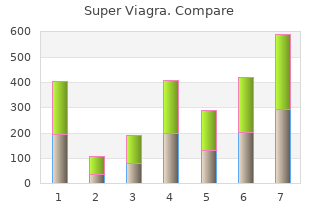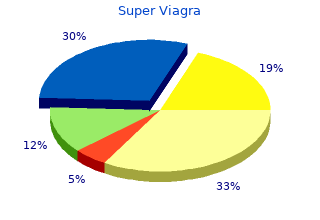Super Viagra
By B. Rocko. Williams Baptist College. 2018.
Currently buy super viagra 160 mg low cost erectile dysfunction rates, physicians have to rely on their experience to decide which areas of tissue to destroy–a task that is complicated by the fact that the electrical activity in every patient’s heart is subtly different order super viagra 160 mg fast delivery impotence propecia. With the aid of a computerized model that reflects the patient’s unique heart structure and function, it may be possible to test the results of destroying different areas of tissue before operating on the patient. Concluding Remarks on Personalized Management of Cardiovascular Diseases Individual responses to drugs vary and are partly determined by genes. Simple genetic analyses can improve response prediction and minimize side effects in cases such as warfarin and high doses of simvastatin. In contrast to monogenic diseases genetic testing plays no practical role yet in the management of multifactorial car- diovascular diseases. Biomarkers can identify individuals with increased cardiovascular risk and biomarker-guided therapy represents an attractive option with troponin- guided therapy of acute coronary syndromes as a successful example (Eschenhagen and Blankenberg 2013). Personalized approaches will gain increasing importance in the management of cardiovascular diseases in the future. Hypertension in the United States 1999–2012: progress toward healthy people 2020 goals. Adducin- and ouabain-related gene variants predict the antihypertensive activity of rostafuroxin, part 1: experimental studies. Genome-wide association analysis of blood-pressure traits in African-ancestry individuals reveals common associated genes in African and non-African populations. Effects of a 5-lipoxygenase–activating pro- tein inhibitor on biomarkers associated with risk of myocardial infarction: a randomized trial. Lipoprotein-associated phospholipase A2 adds to risk prediction of incident coronary events by C-reactive protein in apparently healthy middle-aged men from the general population: results from the 14-year follow-up of a large cohort from southern Germany. Towards personalized clinical in-silico modeling of atrial anatomy and electrophysiology. Adducin- and ouabain-related gene variants predict the antihypertensive activity of rostafuroxin, part 2: Clinical studies. A polymorphism within a conserved beta(1)- adrenergic receptor motif alters cardiac function and beta-blocker response in human heart failure. BiDil in the clinic: an interdisciplinary investigation of physicians’ prescription patterns of a race-based therapy. Universal Free E-Book Store References 509 Polisecki E, Muallem H, Maeda N, et al. Genetic susceptibility to coronary heart disease in type 2 diabetes: 3 independent studies. A new approach with anticoagulant development: tailoring anticoagu- lant therapy with dabigatran etexilate according to patient risk. Pharmacogenetics of clopidogrel: comparison between a standard and a rapid genetic testing. A kinesin family member 6 variant is associated with coronary heart disease in the Women’s Health Study. Using benefit-based tailored treatment to improve the use of antihypertensive medications. Inherited cardiomyopathies: molecular genetics and clinical genetic testing in the postgenomic era. Beta-adrenergic receptor polymorphisms and responses during titration of metoprolol controlled release/extended release in heart failure. A randomized trial of genotype-guided dosing of acenocou- marol and phenprocoumon. Association of vitamin D status with arterial blood pressure and hypertension risk: a mendelian randomisa- tion study. Pharmacogenetic predictors of statin-mediated low-density lipoprotein cholesterol reduction and dose response. Serum parathyroid hormone as a potential novel biomarker of coronary heart disease. Universal Free E-Book Store Chapter 15 Personalized Management of Pulmonary Disorders Introduction There are a large number of pulmonary disorders some of which present challenges in management.
As the kidney attempts to preserve re- nal function and expand blood volume quality 160mg super viagra young healthy erectile dysfunction, renin levels increase and can cause a secondary hypertension order 160mg super viagra with visa erectile dysfunction doctor edmonton. Dysuria can be seen in cases of chronic urinary tract obstruction due to urinary stasis and the propensity to develop urolithiasis. Pain with micturition is a hall- mark of vesicoureteral reflux, which causes a chronic functional obstructive uropathy. The urinalysis is not compatible with acute tubular necrosis because of the absence of granular casts. Calcium oxalate crystals are classically seen in ethylene glycol ingestion, which also causes a high anion gap metabolic acidosis. White blood cell casts indicate an upper urinary tract infection associated with a positive urine culture. Uric acid (rhomboid shapes) or struvite (“coffin lids”) crystals may be seen in cases of nephrolithiasis that causes hydronephrosis. The respiratory compensation for a metabolic alkalosis is limited by the hypoxic drive. Cushing’s disease and mineralocorticoid excess cause a metabolic alkalosis with hypertension. This patient has evidence of hypovolemia with altered mental status, hypotension, and tachycardia. Myocardial infarction causing car- diogenic shock would result in an anion gap metabolic acidosis due to lactate accumulation. Hyperglycemia and hyperlipidemia can cause hyponatremia, but these conditions would be associated with a high and normal plasma osmolality, respectively. A urine analysis is unlikely to be helpful in deciding when to initiate dialysis for this patient. An ionized calcium is a bet- ter marker of the true serum calcium levels but will not assist with diagnosis. This diagnosis requires prompt evaluation and therapy to avoid irreversible renal failure. In the evaluation of proteinuria with hematuria, these features should prompt a serologic and hematologic evaluation and strong consideration of renal biopsy. Since it is already apparent that this patient has proteinuria, ultrasensitive testing for microalbumin is not necessary. Cystoscopy is performed when the source of bleeding is thought to be from the bladder, after renal sources have been eliminated as causes. If the patient is hypertensive and plasma renin is el- evated, renovascular hypertension or a renin-secreting tumor (including Wilms) must be considered and appropriate imaging studies must be carried out. If plasma renin levels are low, mineralocorticoid effect may be high as a result of either endogenous hormone (glucocorticoid overproduction or aldosterone overproduction as in Conn’s syndrome) or exogenous agents (licorice or steroids). In a normotensive patient a high serum bicar- bonate excludes renal tubular acidosis. High urine chloride excretion makes gastrointes- tinal losses less likely and implies primary renal potassium loss, as may be seen in diuretic abuse (ruled out by the urine screen) or Bartter’s syndrome. In Bartter’s syndrome, hy- perplasia of the granular cells of the juxtaglomerular apparatus leads to high renin levels and secondary aldosterone elevations. Such hyperplasia appears to be secondary to chronic volume depletion caused by a hereditary (autosomal recessive) defect that inter- feres with salt reabsorption in the thick ascending loop of Henle. Chronic potassium de- pletion, which frequently presents initially in childhood, leads to polyuria and weakness. A thorough history and physical examination with limited laboratory testing usually yields the appropriate diagnosis. Typical presentations include abdominal discomfort, hematuria, urinary tract infections, or hypertension. Most patients experience a steady decline in renal func- tion over one to two decades following diagnosis. Risk factors for disease progression include male gender, African-American race, hypertension, and the presence of the polycystin-1 mutation. Patients are at an increased risk of subarachnoid and cerebral hemorrhage due to aneurysm formation. Cardiac abnormalities are present in 25% of patients, and most commonly include mitral valve prolapse and aortic regurgi- tation.

Most frequently buy super viagra 160mg lowest price erectile dysfunction causes treatment, a positive culture for yeast represents contamination order super viagra 160 mg with mastercard impotence nhs, even if the urinalysis suggests bladder inflammation. Antifungals are indicated if the patient appears ill, in the context of renal transplant where fungal balls can develop in the graft, and often in neutropenic patients. A positive yeast culture of the spu- tum is usually representative of commensal oral flora and should not be managed as an infection, particularly as in this case where acute bacterial pneumonia is likely. Recurrent disease has been associated with ~10% risk of serious complications including shock, megacolon, perforation, colectomy, or death at 30 days. Met- ronidazole and vancomycin have a similar efficacy in a first episode of recurrence. Unfortunately, patients who recur are more likely to recur again, and many patients receive multiple cy- cles of antibiotics and are even candidates for more extreme measures such as intrave- nous immunoglobulin or fecal transplant via stool enema. A negative stool antigen would not change management, as symptomatic improvement is the true goal of therapy. A positive stool antigen and toxin test in a patient whose symptoms have improved after standard therapy implies coloniza- tion, not disease. It can therefore be needlessly discouraging to patients and again does not impact clinical management. A standard panel will include some or all of the following depending on epidemiologic and historical data: Clostridium difficile stool anti- gen, stool culture, stool Mycobacterium avium intracellulare culture, stool ova and para- site examination and special stains for Cryptosporidium, Isospora, Cyclospora and Microsporidium. Many gram-negative bacteria produce broad-spectrum β-lactamases that confer resistance to penicillins and first-generation cephalosporins. The addition of clavulanate, a β-lactamase inhibitor, to an antibiotic regimen is often enough to overcome this resistance. Important sources of exposure include occupational, recreation in contami- nated waters, and being homeless in contaminated living areas. The conjunctival suffusion during the initial spirochetemic phase of the disease is an important diagnostic clue. Penicillin G is appropriate therapy for severe leptospirosis, but its comparative efficacy is not yet proven in the literature. Acute myelogenous leukemia would likely cause more characteristic abnormalities in blood counts with this degree of illness. Acute interstitial pneumonitis (Haman-Rich syndrome) affects only the lung and would not be associated with the severe increases in bilirubin. Polyarteritis nodosa rarely involved the lung and would not be expected to cause such a high bilirubin, even in the setting of hepatic ischemia. It is transmitted by the dog tick in the eastern two-thirds of the United States and by the wood tick in the western United States. Currently the mortality remains ~5%, mostly due to delayed recogni- tion and therapy. The ini- tial signs and symptoms of Rocky Mountain spotted fever are entirely nonspecific, and the typical rash is often not seen in early disease. Only 60% of patients recall a tick bite, and only 3% of patients have the classic history of tick bite, fever, and rash. Therefore, assessment for this potentially deadly disease should be based on epidemiologic grounds. His recent high- risk travel period for tick bite in a highly endemic region makes this patient a high pretest probability. A diagnostic indirect immunofluorescent antibody test will not be positive (≥1:64 titer) until 7–10 days after symptoms. The only diagnostic test that is useful during the acute illness is immunohistochemical staining for R. Doxycycline is effective therapy and should be continued until the patient is afebrile and improving clinically for 2–3 days. Two remaining minor criteria are not met or not described above: immunologic phenomena (glomerulonephritis, Osler’s nodes, Roth’s spots, rheumatoid factor) and microbiologic phenomena (positive blood cultures that do not meet major criteria or positive serology for an organism likely to cause endocarditis). Major criteria include positive blood cultures and evidence of endocardial involvement (echocardiographic or new valvular regurgitation).


The tissues become hyperplastic with granular or nodular proliferations that precede gingival clefting and extensive areas of recession 160 mg super viagra fast delivery best erectile dysfunction pills treatment. Gross deposits of plaque are inevitable as the soft tissue changes make it difficult to maintain oral hygiene purchase super viagra 160 mg with visa erectile dysfunction causes diabetes. The disease progresses extremely rapidly, with primary tooth loss occurring as early as 3-4 years of age. The entire dentition need not be affected, however, as the bone loss may be restricted to one arch. Children with generalized disease are susceptible to recurrent general infections, principally otitis media and upper respiratory tract infections. Localized disease progresses more slowly than the generalized form and bone loss characteristically affects only incisor-molar teeth. Plaque levels are usually low, consequently soft tissue changes are minimal with gingivitis and proliferation involving only the marginal tissues. The predominant micro-organisms that have been identified are aggressive periodontopathogens: Actinobacillus actinomycetemcomitans, Porphyromonas gingivalis, Fusobacterium nucleatum, and Eikenella corrodens. Profound abnormalities in chemotaxis and phagocytosis of polymorphonuclear neutrophils and monocytes are frequently reported in these patients. These immunological defects are heritable risk factors that help to define phenotypically the disease entity. Conversely, they may also be associated with more serious and life-threatening conditions, and thus a full medical screen is indicated. Oral hygiene instruction, scaling, and root planing should be undertaken at frequent intervals. If pathogens persist after oral debridement, an antibiotic such as metronidazole or amoxycillin (amoxicillin) should be given systemically after sensitivity testing, as a short course over 1-2 weeks. Some improvement has been achieved following a granulocyte transfusion in a patient with a defect in neutrophil function. Extraction of involved teeth has also produced an improvement in neutrophil chemotaxis, which suggests that the defect may be induced by certain organisms in the periodontal flora. Furthermore, in severe cases of generalized periodontitis, extraction of all primary teeth (and the provision of a removable prosthesis) can limit the disease to the primary dentition. When the permanent teeth erupt, bacterial culturing of the subgingival flora ensures that reinfection is detected early. Key Points Primary dentition (prepubertal periodontitis): • localized/generalized; • aggressive pathogens; • intense treatment. The localized form occurs in otherwise healthy individuals, with destruction classically localized and around the first permanent molars and incisors, and not involving more than two other teeth. Generalized periodontitis also occurs in otherwise healthy individuals but involves more than 14 teeth, that is, being generalized to an arch or the entire dentition. Some reports have monitored children suffering from aggressive periodontitis of the primary dentition to find that, at around puberty, the disease became generalized to involve the entire dentition. In the United Kingdom an epidemiological study of 7266 schoolchildren in Coventry and Birmingham showed an overall prevalence of 0. There was no difference in prevalence between males and females, which does not concur with the data of many earlier epidemiological studies of the disease which reported a female to male ratio of 3 : 1. The clinical features are pocket formation and loss of attachment associated with the permanent incisors and first molar teeth. Bilateral angular bone defects are identified on the mesial and, or distal surfaces of molars (Fig. Angular defects are sometimes seen around the incisors, although the very thin interproximal bone is resorbed more evenly to give a horizontal pattern of resorption. The gingiva can appear healthy when the levels of plaque are low, but a marginal gingivitis will be present if a good standard of plaque control is not evident. The pattern may be a combination of angular and horizontal resorption producing an irregular alveolar crest. When patients have good plaque control the degree of bone resorption is not commensurate with the level of oral hygiene. The more generalized nature of the disease predisposes to multiple and recurrent abscess formation which is a common presenting feature.
Super Viagra
8 of 10 - Review by B. Rocko
Votes: 323 votes
Total customer reviews: 323 |



